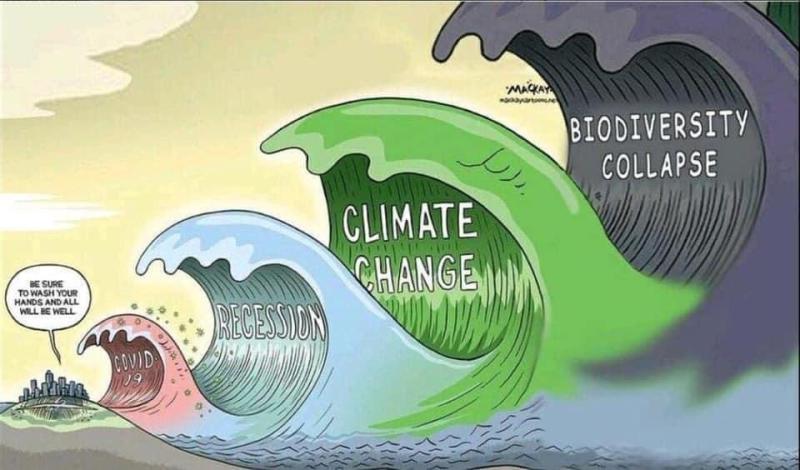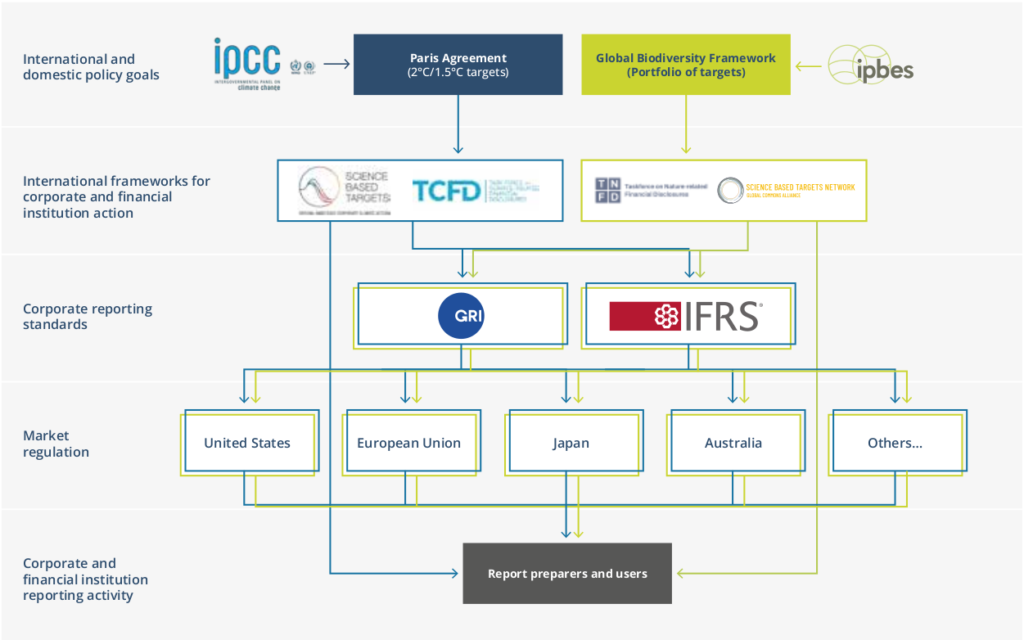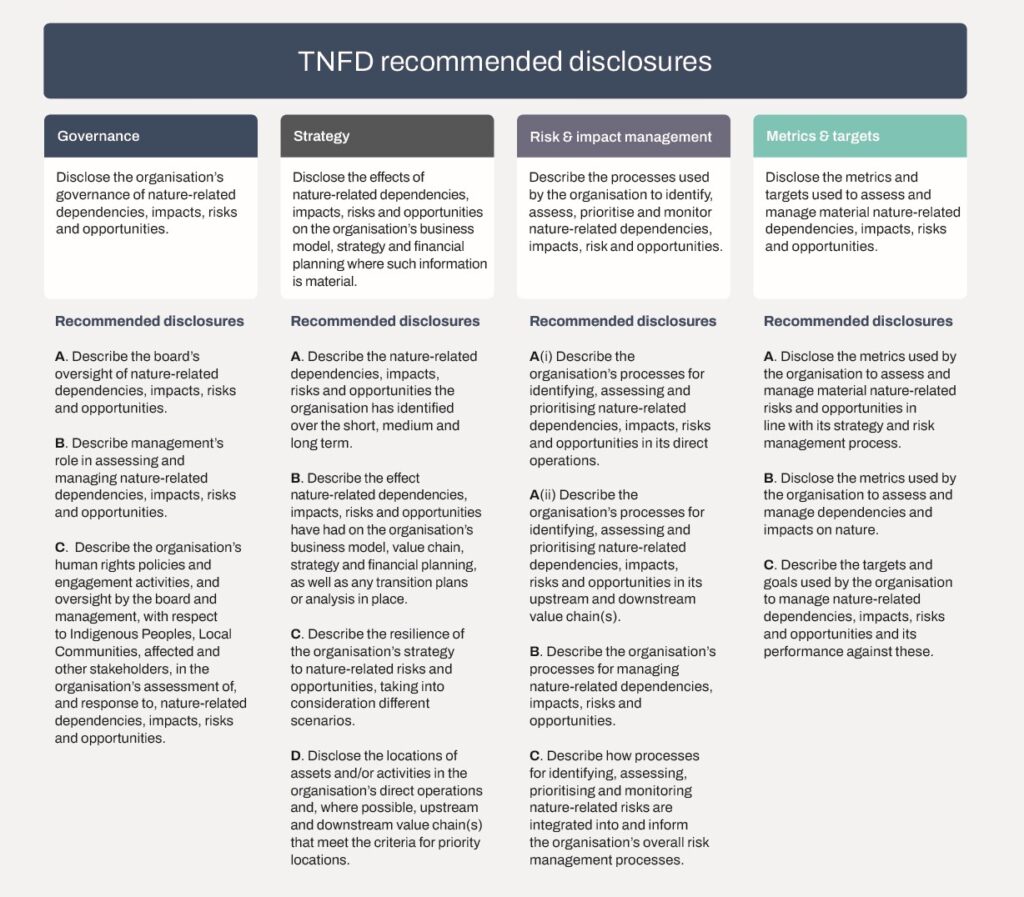
Over the course of the last two or so years, I have posted repeatedly on the developments around Biodiversity. As can well be seen in the title: this is the 9th ‘episode’. And after some results at the COP in Vancouver, the first ever Science -Based Targets for Nature (SBTN), finally (!) the TNFD (Task Force for Nature-based financial Disclosure) published their recommendations after intense work over the course of nearly 2 years.
As with the SBTN, the questions are many. The most obvious one: ‘how do these targets address the 5 key drivers of biodiversity erosion?’ if at all. And: reporting evidently is not creating change – how do they straddle that line? What do they require to report that could be crucial towards change?
In the TCFD (Task Force for climate-based finance disclosure), that bridge was built through the requirements / recommendations for scenario assessments and their publications. And it is indeed more than just a fair guess, that the TNFD is taking in principle at least a similar approach.
Important recap at this point: The 5 Key Drivers
In case you cannot fully remember what those 5 key drivers of biodiversity erosion are, here they are (Souce: IPBES report):
- Invasive (foreign) species
- Pollution
- Climate Change (yep! It’s just one of several!)
- Over-exploitation of natural resources
- Destruction of natural habitats.
(If you are not very familiar with biodiversity related challenges, I recommend participating in a Biodiversity Collage. This is a gamified fully science-based approach to learning about the systemic issues, and it at the same time entertaining and a good team-building exercise.)
It would therefore be logical to expect these 5 dimensions also be represented in the somehow in the TNFD recommendations. So – let’s have a look.
Where does TNFD fit into the bigger picture, and why are they (only) ‘Recommendations’?

Figure 1 shows how the current reporting landscape is being perceived by the TNFD itself.
The illustration is though to be taken with a pinch of salt: Rather than national legislation ‘underpinning’ some of these bigger frameworks, they often run along side, and do not fully accept or rely on international reporting standards. As is for example the case with the EU’s CSRD, or the climate reporting frameworks in California. (Source: TNFD Recommendations, page 20)
The TNFD are ‘recommendations’ which the main purpose to allow investors (!) to assess the due diligence with which a stock listed company is recognising and addressing current and future nature-based risks. At no point therefore, are these recommendations to be understood to focus on the remediation of biodiversity erosion unless such erosion affects a company’s assets or its mid- to long-term profitability.
Some people think that these are of course two complementary perspective, and ‘common sense’ would indeed suppose so. But to be fully clear: as of today, there is not sufficent scientific or otherwise tangible evidence that this is the case, as the data we own is ‘post fact’ and not prospective.
What are the dimensions addressed in the TNFD reporting recommendations?
The TNFD do not really digress from ‘normal’ reporting dimensions. It is more about the ‘what’ of reporting rather than any outcomes the reporting may (or not) drive. The categories put forward are – unsurprisingly: Governance, Strategy, Risk & Impact, and Metrics & Targets.
The more interesting part is though how TNFD defines these dimensions in the context of biodiversity and nature-based disclosure / reporting:
- Governance:
The organisation’s governance of nature-related dependencies, impacts, risks and opportunities. - Strategy:
The effects of nature-related dependencies, impacts, risks and opportunities on the organisation’s business model, strategy and financial planning where such information is material. - Risk & Impact Management
The processes used by the organisation to identify, assess, prioritise and monitor nature-related dependencies, impacts, risks and opportunities. - Metrics & Targets:
The processes used by the organisation to identify, assess, prioritise and monitor nature-related dependencies, impacts, risks and opportunities.
Therefore, while the categories are per se, and expectedly so, ‘traditional’, the refocus on nature-based disclosure and the related nuances are quite clear, and where the novelty can evidently be appreciated.
How do these dimensions map to the 5 pressure areas defined in the IPBES report?
The TNFD uses the concepts of ‘dependencies’ and ‘impact driver pathways’ to link a company’s operations to the 5 pressure areas. These 5 areas are considered ‘the 5 drivers of nature change’.
It is then on the company to find out how they, in how they do business, influence – increasing it or also possibly decreasing it – any one of these 5 drivers. And also how they are influenced by the changes in those 5 drivers.
In order to do that, a company needs to map out in detail:
- Their dependency pathways: how their particular business activities depend upon ecosystem services and specific features of natural capital (stocks of environmental assets).
They in this way are asked to identify how observed or potential changes in natural capital (caused by specific business activities and external factors) affect the costs and/or benefits of doing business. - Their impact pathways: how, as a result of a specific business activity, a particular impact driver (one of the 5 biodiversity erosion pressures) can lead to changes in natural capital (stocks of environmental assets) and flows of ecosystem services, and how these changes affect different stakeholders relevant to the company.
Both of these approaches are, by and large, that the equivalent of the TCFD’s scenario development recommendation.
What is specifically asked for in each TNFD dimension?

Figure 2 lists all of the 14 TNFD-specific reporting recommendations, allocated to their respective dimension.
It is though important to say, that TNFD does not see their recommendations in isolation, but rather sees them as being complementary to
- the 11 disclosure recommendations of the TCFD, and
- Target 15 of the Kunming-Montreal Global Biodiversity Framework.
In addition, they seem to plan for specific sector-recommendations (the first of which is for the Finance industry), which again could be interesting in regards to how these take into account sector-specific risk profiles.
So what: Are these TNFD recommendations worth their salt?
Well, it depends. It is very evident that reporting does very little per se. And as with the TCFD recommendations at the time, this set of reporting dimensions is by far not required homework for stock listed companies.
But: as we can see currently with the EU’s CSRD, or the new climate reporting frameworks in California where TCFD is – in some way, shape or form either integrated or indeed explicitly required – such reporting recommendations can very quickly turn into requirements. And there is no doubt that we’re headed that way.
Moreover, as these recommendations are linked to the Science-based targets for Nature (SBTN) they clearly bring nature and biodiversity into the investor’s spotlight. Not just those that invest into the public stock markets, but also those that invest in non-listed companies.
There is hence no doubt that with the publication of these recommendations not only a flag for Biodiversity is raised, but indeed the topic has firmly been put on the table for companies to pay attention to what will be expected of them rather sooner than later. And this, indeed, is an achievement not to be underestimated. It moves the topic from the side lines to somewhere close to the mainstream. At least in reporting and risk-management terms.

